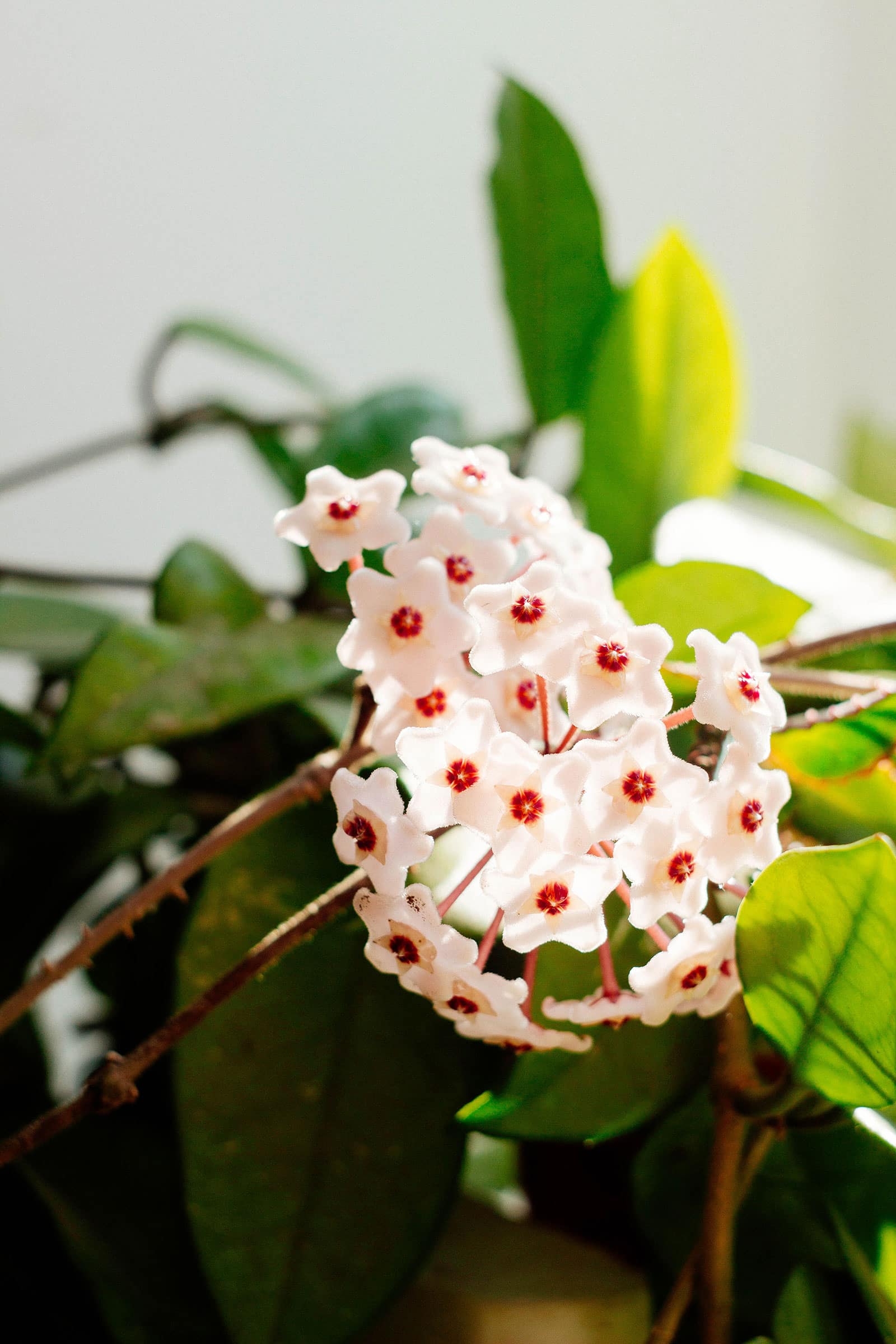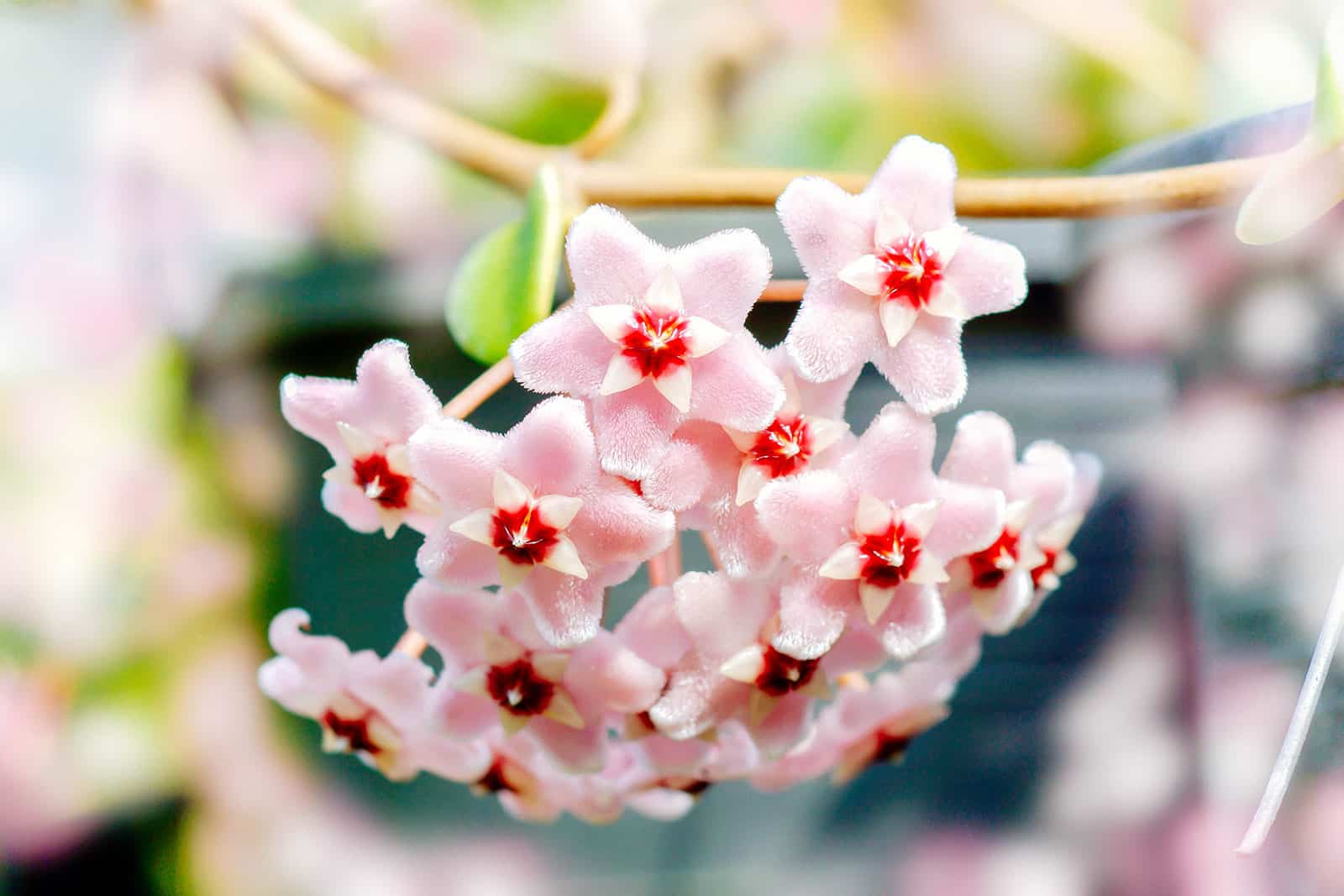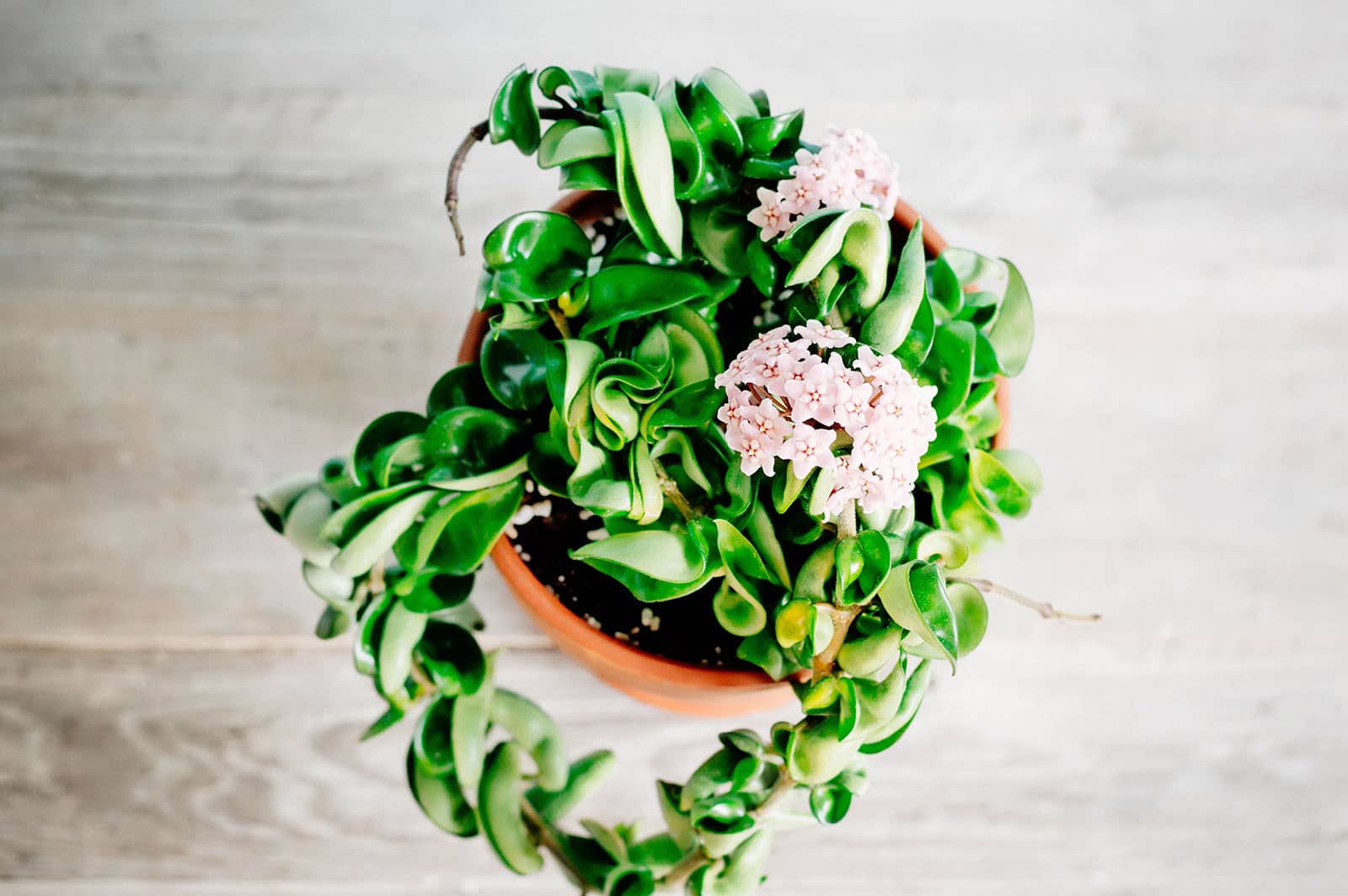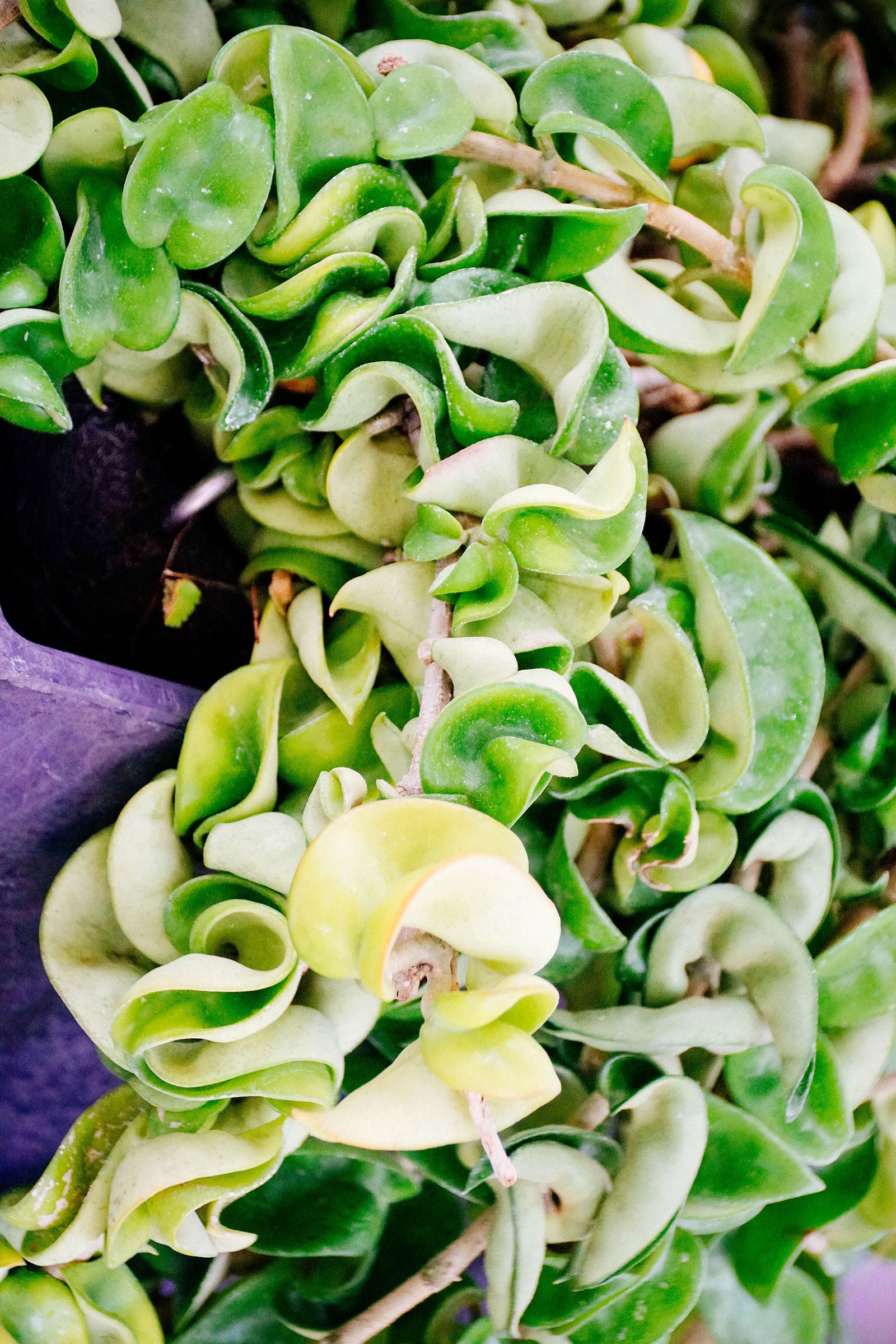Looking for a unique houseplant to add to your collection? Today’s suggestion is Hoya carnosa, a classic indoor plant also known as the wax plant or Hindu rope plant. This species is widely appreciated for its beautiful, wonderfully scented blooms. It’s an easy-care houseplant (perfect for beginners) and there are loads of different varieties to collect!
Keep reading for everything you need to know about Hoya carnosa care and how to grow a wax plant in your own home.
| Common name(s) | Wax plant, porcelainflower, Hindu rope plant |
| Scientific name | Hoya carnosa |
| Family | Apocynaceae |
| Height and spread | Up to 5 feet (hanging, indoors) long and 2 feet wide |
| Light | Bright indirect |
| Soil type | Gritty and well-draining |
| Water | Let dry halfway |
Disclosure: If you shop from my article or make a purchase through one of my links, I may receive commissions on some of the products I recommend.

About Hoya carnosa
Description
The wax plant, scientifically known as Hoya carnosa, is a member of the dogbane (Apocynaceae) family. Specifically, it belongs to a subfamily called the asclepiads or milkweeds, a name that references the latex-like milky sap that its members produce. In fact, if you’ve ever grown milkweed, you might notice the striking similarities in the dainty, star-shaped flowers.
Wax plants have thick, oval leaves growing on spindly stems. They’re considered semi-succulent because they can store water in their foliage, a characteristic that makes them more tolerant of underwatering than many other houseplants.
Like cacti and succulents, this species actually uses a water-saving variation of photosynthesis known as CAM (Crassulacean acid metabolism). I’ll spare you all the nerdy details, but basically, being a CAM plant allows Hoya carnosa to only open its leaf pores at night. Because the air is cooler and more humid during nighttime, this helps it save water.
The most striking part of a wax plant, and one of the reasons so many people grow it, is its flowers. Hoya carnosa produces large, round clusters of blooms in spring or summer, which consist of many small individual flowers. One inflorescence can have up to 50!
The flowers are soft pink and star-shaped, covered in a very fine layer of fuzz. They smell divinely sweet (oftentimes like chocolate!) and produce so much nectar that you can sometimes see drops oozing and falling from the flower cores. This nectar is very sticky, so you may want to place a few paper towels under the flowers to prevent it from ending up all over your furniture or floor.
By the way… Hoya flower nectar is non-toxic and it tastes just as good as the flowers smell. If you’ve ever licked your wax plant’s flowers, know that you’re not alone!
Natural habitat
This popular houseplant is native to (sub)tropical areas in Asia. Specifically, it’s naturally found in China, Laos, Taiwan, and Japan, although some sources also note its presence in Queensland, Australia, as well as Fiji.
Hoya carnosa prefers tropical or subtropical rainforests. Here, it grows mostly like an epiphyte or lithophyte: on trees (in a non-parasitic manner) or on rocks, using any bits of soil or debris present to help anchor itself. (This behavior can be seen on other epiphytic/lithophytic houseplants, including favorites like Hoya kerrii, Syngonium podophyllum, Peperomia prostrata, Tillandsia, and Epiphyllum.)
Wax plants are vining in nature and can climb to great heights if given the opportunity.
Did you know? In its natural range, Hoya carnosa is pollinated by moths. The moths walk across the flower clusters looking for tasty nectar, causing the plants’ pollen to stick to their legs. This explains why scientists have found the flowers’ scent as well as nectar production to be strongest at night: it helps the Hoya to attract these nocturnal insects.

Hoya carnosa varieties
If you want to know more about the different cultivars and hybrids of Hoya carnosa, it’s important to keep in mind that this topic is widely disputed. Like, really disputed, as far as plants go. There are some old, established cultivars, but there are also many whose origins seem a little iffy.
Hoya enthusiasts often note that nurseries will slap any name on an unpatented wax plant variety just to be able to pretend it’s something shiny and new. This allows them to sell the plant for more money, sometimes into the hundreds of dollars!
That’s why you should take any new wax plant variety being hyped online (which happens a lot) with a grain of salt. It’s always a good idea to think twice before shelling out a lot of money for a Hoya.
It doesn’t help that there’s no real directory available, nor official control besides patents (which definitely aren’t always filed). I’ve tried to gather the most extensive information possible to hopefully shed some light on the matter and clear up some confusion!
In addition to the more common Hoya varieties discussed in my Hoya plant roundup, you’re also likely to come across these cultivars:
- Hoya carnosa ‘Stardust’: A freckled variation similar to ‘Freckles Splash’. Looks pretty much identical.
- Hoya carnosa ‘Wilbur Graves’: Also sports splashy leaves. Looks very similar to the previous splash cultivar, but goes for $100+ for some reason. This is despite the fact that its origins are pretty unclear and widely disputed!
- Hoya carnosa ‘Chelsea’: Features heart-shaped leaves that look dimpled. Note that six dimples per leaf indicates you’re dealing with a ‘Chelsea’ rather than a ‘Krinkle 8’.
- Hoya carnosa ‘Jade’: Sometimes simple is best, so this one has fully green leaves with no splashing or variegation.
- Hoya carnosa ‘Brazil’: Apparently the result of a “cross” between ‘Rubra’/’Krimson Princess’ and ‘Chelsea’ or ‘Compacta’… but really, it’s so similar to the former that you might as well buy that one.
- Hoya carnosa ‘Snowball’: Bred by a well-known Hoya grower named Genevieve McDonald. It’s similar to a ‘Tricolor’, but has more rounded leaves.
- Hoya carnosa ‘Amore’: So similar to ‘Chelsea’ that it’s sometimes used as a synonym for that one. If you like them, just go for whichever’s cheaper.
- Hoya carnosa ‘Holliana’: Quite a unique variety, with small, crinkly and variegated leaves.
- Hoya carnosa ‘Nova Ghost’: Apparently a reverted ‘Argentea Princess’, meaning a plant that has lost its variegation, by KOKO Ranch. Remember that grey varieties of H. carnosa are pretty slow-growing.
- Hoya carnosa ‘Grey Ghost’: Very, very similar to ‘Nova Ghost’, and not much information out there about its origins. Despite this, it’s generally cheaper than its twin!
Where to buy Hoya carnosa plants:

Caring for Hoya carnosa
Light and temperature
Scientists have actually done a bit of research into Hoya carnosa light requirements. They found that sometimes, data suggested that the plant was better adapted to shaded conditions under the forest canopy. Other times, though, it seemed to prefer exposed conditions, or full sun.
Conclusion? Both seem to work well, which makes sense for a climbing epiphyte/lithophyte like this. After all, some of its leaves can be under the canopy, while others are exposed to full sun.
In the home, the best way to ensure yours grows well without burning is to place it next to a window that receives bright, indirect light. Artificial lighting (grow lights) also works well.
In terms of temperature, this plant is relatively forgiving. Unlike many of our tropical favorites (Alocasias, I’m looking at you), Hoyas also grow in subtropical forests, meaning they’re better adapted to chilly conditions. They prefer temps of 59°F or up, but will generally be fine as long as they’re not exposed to frost.
Water and humidity
Although its waxy leaves may seem to suggest that you should treat your Hoya carnosa like a succulent, that’s not exactly the case. After all—as we discussed in the section on habitat—this species actually naturally grows in rainforests!
It’s true that these forests can be subject to dry periods, which is why wax plants evolved to be semi-succulent and are pretty forgiving about underwatering. However, they really do prefer plenty of moisture.
For the best results, water your Hoya carnosa once the top of its soil has dried out. During the active summer months, you can water when the first 2 inches or so feel dry when you stick a finger into the pot.
In winter, when houseplants need less water, it’s generally better to wait until the soil has dried about halfway.
Like many popular jungle-y houseplants, your wax plant won’t be a fan of low humidity. Not surprising, since moisture levels in its natural habitat tend to hover between 90 to 99 percent for most of the year! If your home is on the dry side, which can happen during winter in particular, you may find that your plants will perk up more from the use of a humidifier.
Soil and planting
As you’ve read in the section on Hoya carnosa’s natural habitat, this houseplant naturally grows as an epiphyte or lithophyte. It uses rocks or trees as support while it climbs its way to the top of the jungle, rather than growing in soil.
This natural manner of growing affects how you should pot your wax plant in the home. It won’t appreciate being grown in a dense soil medium: its roots aren’t used to being constrained or cut off from ample airflow. So, gritty and well-draining soil works best.
Mixing your own Hoya carnosa soil isn’t too much of a challenge. All growers have their own preferences, with some cultivating their Hoyas in pure grit without any added potting soil. For our home mixture, though, the easiest solution is something like this:
- 1 part commercial succulent/cactus soil
- 1 part fine orchid bark
- 1 part perlite
If you find the soil dries a little too quickly, you can add a handful of coco coir or sphagnum moss for better water retention.
When it comes to choosing a planter, the first step is to consider whether you want to let your wax plant hang or climb. These Hoyas are commonly sold as hanging plants, and they do look great in a nice hanging basket where their vines are allowed to cascade.
However, as we’ve found out, they’re actually vining climbers. Yours would love to be allowed to climb a totem or trellis!
Whatever type of planter you end up choosing for your wax plant, remember that it should always have a drainage hole.
Recommended products for Hoya carnosa plant care:
- Hoffman Organic Cactus and Succulent Soil Mix
- Soil Sunrise Philodendron Houseplant Potting Soil
- Perfect Plants Organic Perlite
- Better-Gro Orchid Bark
- Totem Monkey Extendable Coir Moss Poles
Fertilizing
Because Hoya carnosa isn’t exactly the quickest grower among houseplants, the species isn’t a very heavy feeder either. That doesn’t mean it won’t enjoy a little boost during the active summer growing months, though!
You can use a balanced regular houseplant fertilizer once or twice a month to make sure your wax plant grows well. Some enthusiasts recommend switching to a fertilizer that has a little more flower-boosting phosphorus if it looks like your plant is gearing up to bloom, but this isn’t a must.
You don’t have to fertilize during winter.
Recommended fertilizers for Hoya carnosa plants:
- Houseplant Resource Center Liquid Fertilizer for Houseplants
- Instant Biologics Instant Plant Food (Fizzing Nutrient Tablets)
- Maxsea All-Purpose Seaweed Plant Food
Pruning
Your wax plant won’t need much in the way of pruning. You can remove any dead or unsightly leaves, but if you cut entire vines for one reason or another, it would be a pity to discard those. Instead, head over to the section on propagation in order to find out how to multiply them.
Dividing or repotting
Good question! Most specimens of Hoya carnosa consist of several vines rooted in the same planter. This means that once the plant outgrows its pot, you could consider separating one or two of these to give the remaining vines more space.
This being said, most folks prefer a fuller look, which removing vines can take away from. If you’re in this camp, repotting can be done by refreshing the soil and going one pot size up during spring. Since these plants don’t mind being a bit cramped, it’s probably not something you’ll have to do every year.

Propagating Hoya carnosa
Ahh, the magic of propagation—better known as turning one plant into multiple for free. This is absolutely something you can do with a wax plant, and quite easily as well! As with all houseplants, propagating a wax plant is best done during spring or summer.
Removing (parts of) Hoya vines is a great way to obtain cuttings. Include a few leaves when you cut off a section of vine. All you have to do after this is pop the cutting in some fresh, lightly moist Hoya soil or set it in water to root and pot it up later.
Vine cuttings should root readily, so it’s easy to create your own army of wax plants to keep or give away.

Is Hoya carnosa toxic to cats and dogs?
Nope! Although its white sap can look dangerous, Hoya carnosa is actually considered non-toxic to animals and humans. It’s a great plant to grow if you have furbabies that are prone to munching on your greenery.
Sources:
https://patentimages.storage.googleapis.com/b6/3a/90/be7ac0d848cc01/USPP3307.pdf
https://patentimages.storage.googleapis.com/e9/75/16/cab09e456e6987/USPP3105.pdf
https://patentimages.storage.googleapis.com/ae/69/99/ef9a16c64f06c9/USPP4199.pdf
https://www.hoyahoya.nz/blog/happy-birthday-mr-hummel
https://cubits.org/Hoya/thread/view/65881/
https://powo.science.kew.org/taxon/urn:lsid:ipni.org:names:107308-3
https://en.wikipedia.org/wiki/Crassulacean_acid_metabolism
Altenburger, R., & Matile, P. (1988). Circadian rhythmicity of fragrance emission in flowers of Hoya carnosa R. Br. Planta, 174(2), 248-252.
Martin, C. E., Hsu, R. C. C., & Lin, T. C. (2010). Sun/shade adaptations of the photosynthetic apparatus of Hoya carnosa, an epiphytic CAM vine, in a subtropical rain forest in northeastern Taiwan. Acta physiologiae plantarum, 32(3), 575-581.
Matile, P. (2006). Circadian rhythmicity of nectar secretion in Hoya carnosa. Botanica Helvetica, 116(1), 1-7.
Mochizuki, K., Furukawa, S., & Kawakita, A. (2017). Pollinia transfer on moth legs in Hoya carnosa (Apocynaceae). American Journal of Botany, 104(6), 953-960.
Sherson, D., Nielsen, A. D., Mortz, C. G., Vestergaard, L., Brandt, L. P. A., Jørs, E., & Bælum, J. (2017). Occupational rhinoconjunctivitis caused by the common indoor plant, Hoya compacta. Occupational Medicine, 67(6), 490-492.















